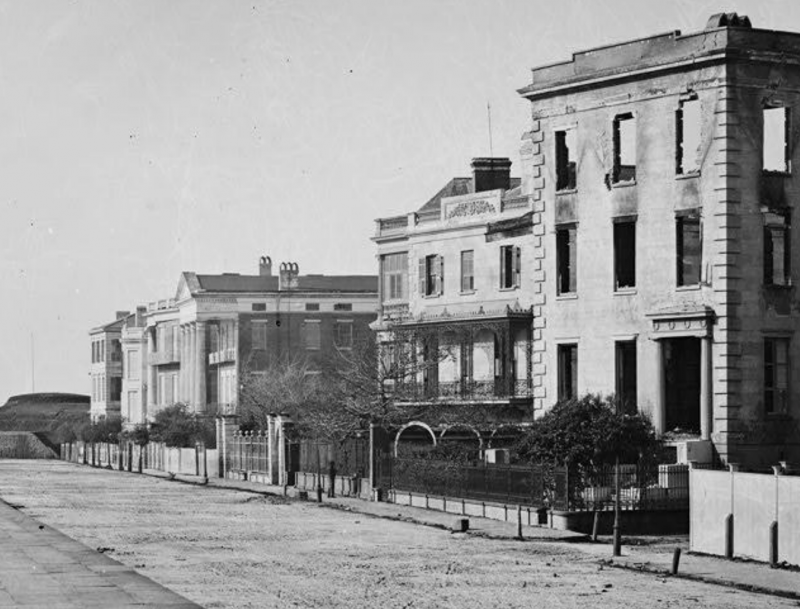Three Moments in White and Black History in Charleston, South Carolina

No doubt the last thing that [Denmark] Vesey and his co-conspirators expected was that there would be whites in Charleston who supported their revolt…. At the time of the trial, the four men were all judged to have been between forty and fifty years of age…. in place of asking the men their actual ages, the court visually estimated and recorded them — a humiliating practice typically reserved for African American in legal proceedings, thereby conferring at the outset a kind of “less than white” status on the four….
The first white defendant, William Allen… “spoke of large parcels of arms secreted near the city….” Allen’s overtures had been reported by two free blacks… “The negroes objected that he (Allen) being a white man, could not be safely trusted by them. To this he replied, that ‘though he had a white face, he was a negro in heart.’”
John Igneshias, the second white defendant, was described as being “a Spaniard, a seafaring man….” As with the other white men on trial, the most damaging evidence against Igneshias were white witnesses, who testified that he had angrily declared to slaves in town after the plot’s discovery that “he disliked everything in Charleston, but the Negroes and the sailors.” According to testimony, Igneshias additionally exclaimed, “Damn them [the whites], I would kill them all.”
The third defendant… was overheard by a “respectable” white male witness… “speaking to several negroes concerning the execution of some of the slaves. ‘Poor creatures,’ said he, ‘my heart bleeds for you; the negroes executed were innocent… you… ought not to have permitted it… and you must rescue those who are still to be hanged.’”
The fourth defendant… allegedly came offering to lead two thousand men against the state, declaring that “the Negroes ought to fight for their liberty” and “that they had as much right to fight for their liberty as the white people….”
Not surprisingly… two of these reputed offers of aid… however well intentioned, were also paternalistic-sounding schemes to lead, not follow, large numbers of armed black people to freedom.
— Philip F. Rubio, “’Though he had a white face, he was a negro in heart’: Examining the white men convicted of supporting the 1822 Denmark Vesey slave insurrection conspiracy,” The South Carolina Historical Magazine, Vol. 113, No. 1 (January, 2012)
Slavery in Charleston ended when the 21st United Colored Troops, the 54th and 55th Massachusetts Volunteer Regiments, and the former slaves of the 3rd and 4th South Carolina Regiments entered Charleston in 1865. Charleston’s “black community… began taking charge of the new situation and assert themselves” as free people equal to whites. They “viewed themselves as a ‘working class of people’ seeking to benefit from ‘the fruits of their labor….’”
Nevertheless, slaves who were domestics redefined the rules of work and decided which white employer would employ them. Many left their former master/mistress for new employers as a means of creating personal autonomy. Blacks even fought off white plans to replace them with Asian and European immigrant labor. African Americans defined personal freedom by establishing bank and savings accounts for dependents in the Freedmen’s Bank…. African Americans understood that “freedom was a battle.” They gave no quarter in their attempts to maintain their new found freedom…. While African Americans defended themselves on Charleston’s streets from abusive white police officers, white Union soldiers, and whites who refused to recognize black freedom, Charleston’s African Americans could not protect themselves from the economic depressions…. They built their churches and paid educational tuition out of salaries constrained by local, national and global depressions.
— Gregory Mixon, “Reviewed Work: Seizing the New Day: African Americans in Post-Civil War Charleston by Wilbert L. Jenkins,” The Journal of Negro History Vol. 86, No. 1 (Winter, 2001).
In late winter 1867 the Congressional Reconstruction Acts imposed military rule on the South and required a non-racial franchise…. When a constitutional convention was held in the city during early 1868, over one-half of the delegates were black. This convention instituted universal male suffrage…. In May thirteen of eighteen aldermen were also removed and seven of their appointed replacements were black… All had been free before the war and represented a new class of leadership in Charleston’s black community. Throughout the period, except for the years 1871–1873, half the seats in the city council were occupied by black men….
The reaction of white Charleston to the prospect of black officials was swift and negative. They felt that the seeming social and political equalitarianism of Reconstruction degraded their once glorious city to the depths of a Paris gripped in the throes of the French Revolution. Chagrined at the unfolding scenes of Reconstruction, Eliza Holmes wrote a friend, “we are being made however, day by day, to realize, the… equalities of all things.” Aghast at the appointment of the black Dr. Benjamin Boseman as postmaster for the city, Holmes continued, “surely our humiliation has been great when a Black Postmaster is established here at Headquarters and our Gentlemens Son’s [sic] to work under his biddings — .” Bearing incredulous witness to the changes in the city council under military rule, Augustine Smith wrote in disgust, “we actually have negroes in Council. It is the hardest thing we have yet had done to us.”
— Bernard E. Powers, Jr., “Community Evolution and Race Relations in Reconstruction Charleston, South Carolina,” The South Carolina Historical Magazine, Vol. 95, No. 1 (Jan., 1994)
